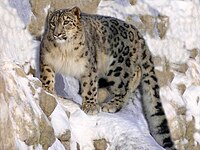
Photo from wikipedia
Growing threats to biodiversity demand timely, detailed information on species occurrence, diversity and abundance at large scales. Camera traps (CTs), combined with computer vision models, provide an efficient method to… Click to show full abstract
Growing threats to biodiversity demand timely, detailed information on species occurrence, diversity and abundance at large scales. Camera traps (CTs), combined with computer vision models, provide an efficient method to survey species of certain taxa with high spatio-temporal resolution. We test the potential of CTs to close biodiversity knowledge gaps by comparing CT records of terrestrial mammals and birds from the recently released Wildlife Insights platform to publicly available occurrences from many observation types in the Global Biodiversity Information Facility. In locations with CTs, we found they sampled a greater number of days (mean = 133 versus 57 days) and documented additional species (mean increase of 1% of expected mammals). For species with CT data, we found CTs provided novel documentation of their ranges (93% of mammals and 48% of birds). Countries with the largest boost in data coverage were in the historically underrepresented southern hemisphere. Although embargoes increase data providers' willingness to share data, they cause a lag in data availability. Our work shows that the continued collection and mobilization of CT data, especially when combined with data sharing that supports attribution and privacy, has the potential to offer a critical lens into biodiversity. This article is part of the theme issue ‘Detecting and attributing the causes of biodiversity change: needs, gaps and solutions’.
Journal Title: Philosophical Transactions of the Royal Society B: Biological Sciences
Year Published: 2023
Link to full text (if available)
Share on Social Media: Sign Up to like & get
recommendations!